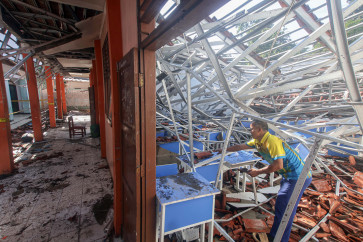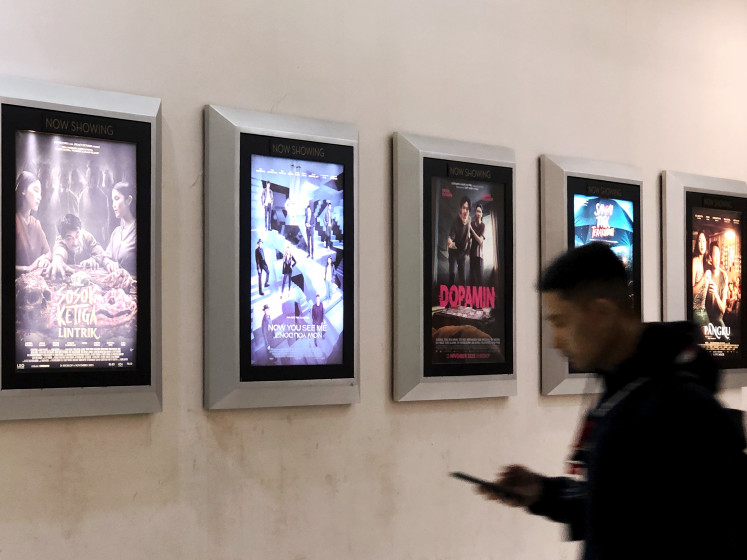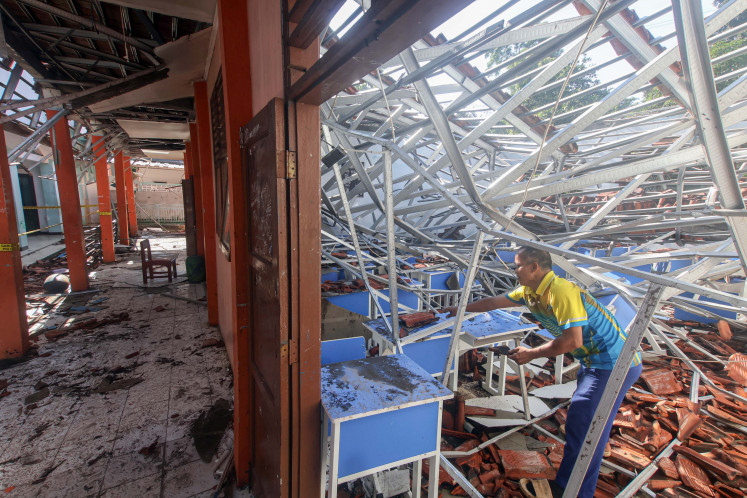Popular Reads
Top Results
Can't find what you're looking for?
View all search resultsPopular Reads
Top Results
Can't find what you're looking for?
View all search resultsCemeteries: Your next weekend destination?
Cemetery highlights: The Khouw mausoleum in Petamburan Cemetery, Central Jakarta, stands less imposingly compared to when it was first built over 100 years ago due to lack of maintenance
Change text size
Gift Premium Articles
to Anyone
Cemetery highlights: The Khouw mausoleum in Petamburan Cemetery, Central Jakarta, stands less imposingly compared to when it was first built over 100 years ago due to lack of maintenance.
The lack of public spaces and green areas in the city might call for alternative recreational places, including cemeteries, which Jakartans normally avoid because of their eerie reputation.
“Other countries have been using their cemeteries as recreational areas. I don’t see why Jakarta can’t turn some of its graveyards as public areas where people can enjoy a nice view and a calm atmosphere,” Jakarta Green Map coordinator Nirwono Joga said recently.
Nirwono said several cemeteries had the potential to become recreational as well as educational areas, due to their picturesqueness and rich histories: the Menteng Pulo war memorial cemeteries, the Karet Bivak Cemetery and the Petamburan Cemetery.
Last Saturday, he took around 50 members of the Jakarta Folding Bike community on a tour of Jakarta’s cemeteries. The bikers rode the Transjakarta bus to the Karet Bivak Cemetery in Central Jakarta before continuing their trip to the Menteng Pulo war cemeteries in South Jakarta.
“The Menteng Pulo cemeteries are very scenic and well-tended,” Nirwono said, “One can sit in the shade and just enjoy the view.”
Two other cemeteries in the Menteng Pulo area include the Ereveld Menteng Pulo (Menteng Pulo cemetery grounds), which serves as a memorial for members of the Dutch army who were killed during the wars that occurred between 1945 to 1949, and the Jakarta War Cemetery (JWC), which contains bodies of British and Commonwealth soldiers who also died in the 1940s.
The two are a far cry from most cemeteries in Jakarta, which are often engulfed in wild shrubs and prone to floods.
For instance, in the Evereld, amid rows of white crosses erected in neat lines stands a small mausoleum adorned with four symbols of faith: the cross, the crescent moon, the star of David and the Yin and Yang.
The marble and steel gates of JWC, meanwhile, barely conceal its imposing Cross of Sacrifice, which stands at the intersection of two grass avenues among glimmering tombstones. Just a few meters inside the cemetery stands an obelisk-shaped monument with two wreaths engraved on it.
Both cemeteries, squeezed among high-rise apartments and construction sites of the Casablanca Street, offer comfortable places to sit as well as adequate shade under well-tended trees.
To visit the Menteng Pulo cemeteries, one must request a permit from the foundations preserving those grounds.
“We only had to wait one day before getting our permit,” Nirwono said, “But it would be far more convenient if we could ask for the permit on arrival at the cemetery.”
He added although the Karet Bivak Cemetery was not be as well-maintained as its Menteng Pulo counterparts, it nevertheless offered considerable insights into the country’s history.
“A number of influential figures in Indonesian history are buried there, but not many [people] are aware of that fact,” he lamented.
Graves of notable personalities include that of national war hero MH Thamrin, President Soekarno’s wife Fatmawati and poet Chairil Anwar.
These graves were quite well-tended, especially that of MH Thamrin, which has its own complex housing twelve other graves belonging to his relatives. However, the overall condition of the Karet Bivak Cemetery resembles most of the other neglected cemeteries in the city.
“If only they could take better care of the cemetery, it would probably be a good place to learn more about the country’s history,” Nirwono said.
However, like most cemeteries in Jakarta, the Karet Bivak Cemetery is looked after by self-employed grave caretakers, paid by family members of the deceased. These caretakers are mostly unwilling to tend to other graves besides the ones they are paid to look after.
The Petamburan Cemetery in West Jakarta also depends on these caretakers. Thus, several histori-cally rich graves are currently neglected and crumbling because no one is willing to pay for maintenance costs.
One stark example is the elaborate European-style mausoleum containing the preserved body of a legendary Chinese landlord named Khouw Oen Giok and his wife’s ashes. Both died in 1957.
The once luxurious domed building holding angel statues is now flooded, with some of its marble stones knocked out of place.
“No one spends any money on this building, so it is now rundown,” Bob, one of the caretakers in Petamburan cemetery said.
Other tokens of history in danger of facing neglect and even demolition are the Jewish graves found in the eastern part of the cemetery. Several of the triangular-shaped sarcophagi have already been replaced with newer graves.
The few remaining might face a similar fate due to a lack of funds to pay maintenance costs.
“Those Jewish graves are unique since they prove that there were once Jewish people residing here,” Nirwono said.
“We can see that people in the past were probably more tolerant,” Nirwono said, “after all, graves don’t lie.” (dis)










